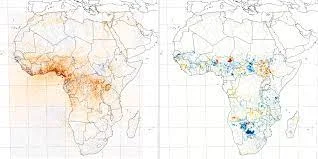Because of fires and agricultural expansion, ammonia gas pollutes the atmosphere of Africa
Understanding how sources of ammonia emissions change is important for developing policies and technologies that promote sustainable agricultural development, and help mitigate their potential effects on the atmosphere.
The results of a new scientific study showed that the concentration of ammonia gas is constantly rising in the atmosphere of Africa, and researchers have linked this rise to the phenomena of burning biomass and the expansion and intensification of agricultural practices.
The study, which is the first of its kind conducted by NASA during the decade between 2008 and 2018, identified "hot spots" located in West Africa and in the Lake Victoria region, where the highest levels of this polluting gas to the environment and harmful to health were recorded.
Ammonia and its potential sources
It is known that ammonia - or ammonia gas whose molecule consists of one nitrogen atom and 3 hydrogen atoms - pollutes the air, and can lead to heart and lung diseases. Its presence in high concentrations in an ecosystem makes the soil more acidic and stunts plant growth.
This gas is naturally emitted from soil and vegetation fires, but previous scientific studies have proven that agricultural activities such as raising livestock and using fertilizers are also major sources of it.
Expanding agriculture to meet the needs of a growing population is likely to lead to higher ammonia emissions as well.
Although scientists have been interested in studying these emissions over a long period in different regions of the world, the situation in Africa has been somewhat neglected by researchers.
To create a comprehensive view of ammonia emissions over Africa, an international team of researchers led by NASA used satellite data from 2008 to 2018, to determine the concentrations, distribution, trends and possible causes of ammonia gas in the continent's atmosphere.
The results of the study were recently published in the scientific journal "Atmospheric Chemistry and Physics" on November 16.
The results of satellite data analysis showed - according to a statement published on the NASA website - that West Africa is among the global hotspots for ammonia emissions in the atmosphere.
The annual increase in the concentration of this gas across Nigeria, for example, is 6% during the months of February and March, coinciding with a rise in carbon monoxide in the atmosphere.
This period coincides with the end of the dry season and farmers preparing their lands by burning them before adding fertilizer, which negates what previous studies have suggested that the increase in ammonia emissions in the region is due to the use of chemical fertilizers in agriculture.The study also identified areas of the Lake Victoria Basin and wetlands in southern Sudan, as regional hotspots for ammonia emissions.
In the Lake Victoria region, the results of the study indicate that the expansion of the agricultural area and the use of fertilizers led to an increase in ammonia concentration during the study period.
The researchers linked the growth of concentrations of this gas over this area with data indicating that farmers were using more fertilizers in agricultural lands that are witnessing a steady increase in their area, according to the statement.
In South Sudan, soil moisture caused a decrease in ammonia concentration during the study period. The wetlands in the "Al-Sad" area, which covers an area of 30,000 square kilometers and is fed by the Nile River, was the only area that showed a clear decrease in the ammonia level during the study period, which amounted to about 1.5 percent annually.
The researchers found that ammonia concentrations increase in dry years, when more wetlands dry out, and decrease in rainy years.
Sustainable agriculture to reduce ammonia emissions
According to the researchers, agriculture is the largest source of ammonia in the world, although it is also emitted naturally from the soil. The burning of biomass is the second largest source of this polluting gas in the world, and Africa is the origin of nearly 70% of these fires.
As African nations expand their agricultural activity to feed a growing population that will double by mid-century, ammonia concentrations are expected to continue to rise in the atmosphere over the continent in the future.
Understanding how sources of ammonia emissions change, according to the researchers, is important for developing policies and technologies that promote sustainable agricultural development, and help mitigate its potential effects on the atmosphere.
For its part, NASA called for strengthening the capacity to monitor the atmosphere in sub-Saharan Africa.
Tags:
cambridge science
electrical sciences
genomic sciences
geosciences
life science
live science
neuroscience
science
science magazine
space science
strait of science






Good
ReplyDeleteGood
ReplyDelete
ReplyDeleteIn the Lake Victoria region, the results of the study indicate that the expansion of the agricultural area and the use of fertilizers led to an increase in ammonia concentration during the study period
Great
ReplyDeleteGreat
ReplyDeleteUpsetting!
ReplyDelete